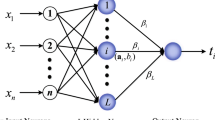Abstract
Real-time prediction of the sulphur content of steel is of great importance for operation guidance during ladle furnace (LF) steel refining. For seeking an accurate prediction, this paper proposes to establish sulphur content prediction model in a hybrid way, where a simplified first principle model is introduced and fine tuned by data-driven modelling methods. The derived hybrid model employs optimization approach to optimize its data representation part, while prior knowledge is embedded in the form of linear constraints. An innovation of the proposed methodology is the full exploitation of prior knowledge about the process for determining reasonable process parameters. Moreover, a novel optimization approach is developed for ensuring accuracy and improving solution efficiency by the integration of genetic algorithm and successive approximation method. The proposed hybrid model possesses flexible interpretable structure and adaptive learning ability. As a result, it ensures the extrapolation property for real-time prediction and is able to provide an in-depth understanding of practical desulphurization process, making it very suitable for process monitoring and operations optimization during LF steel refining. Finally, this hybrid model is validated on recorded data from an industrial LF plant.







Similar content being viewed by others
References
Cyril NS, Fatemi A (2009) Experimental evaluation and modeling of sulfur content and anisotropy of sulfide inclusions on fatigue behavior of steels. Int J Fatigue 31(3):526–537
Richardson FD (1974) Physical chemistry of melts in metallurgy. Academic Press, London
Andersson M, Hallberg M, Jonsson L, Jonsson P (2002) Slag–metal reactions during ladle treatment with focus on desulphurisation. Ironmak Steelmak 29(3):224–232
Hallberg M, Jonsson TLI, Jonsson PG (2004) A new approach to using modelling for on-line prediction of sulphur and hydrogen removal during ladle refining. ISIJ Int 44(8):1318–1327
Jonsson PG, Jonsson LTI (2001) The use of fundamental process models in studying ladle refining operations. ISIJ Int 41(11):1289–1302
Zhang HS, Zhan DP, Jiang ZH (2007) Final sulfur content prediction model based on improved BP artificial neural network for hot metal pretreatment. Iron Steel 42(3):30–32
Feng JH, Li XJ, Zhu XH (2007) Prediction model of sulfur end-point content for oxygen converter based on neural network. Res Iron Steel 35(2):33–35
Lv W (2009) The research on sulfur content prediction model for LF. Master, control theory and control engineering, Northeastern University, Shenyang
Choi JY, Kim DJ, Lee HG (2001) Reaction kinetics of desulfurization of molten pig iron using CaO–SiO2–Al2O3–Na2O slag systems. ISIJ Int 41(3):216–224
Fincham CJB, Richardson FD (1954) The behavior of sulphur in silicate and aluminate melts. Proc R Soc Lond 223:40–62
Pirker S, Gittler P, Pirker H, Lehner J (2002) CFD, a design tool for a new hot metal desulfurization technology. Appl Math Model 26:337–350
Mutlu M, Popescu SC, Stripling C, Spencer T (2008) Mapping surface fuel models using lidar and multispectral data fusion for fire behavior. Remote Sens Environ 112(1):274–285
Iida T (2002) Equations for estimating the viscosities of molten slags and glasses. J High Temp Soc 28:49–53
Iida T (2002) Accurate prediction of the viscosities of SiO2–Al2O3–CaO–MgO melts. Curr Adv Mater Process 15:203–208
Forsbacka L, Holappa L, Iida T, Kita Y, Toda Y (2003) Experimental study of viscosities of selected CaO–MgO–Al2O3–SiO2 slags and application of the Iida model. Scand J Metall 32:273–280
Huang GB, Zhu QY, Siew CK (2006) Extreme learning machine: theory and applications. Neurocomputing 70:489–501
Lou H, Su H, Xie L, Gu Y, Rong G (2012) Inferential model for industrial polypropylene melt index prediction with embedded prior knowledge and delay estimation. Ind Eng Chem Res 51:8510–8525
Milanic S, Strmcnik S, Sel D, Hvala N, Karba R (2004) Incorporating prior knowledge into artificial neural networks—an industrial case study. Neurocomputing 62:131–152
Renner G, Ekart A (2003) Genetic algorithms in computer aided design. Comput Aided Des 35(8):709–726
Baumal AE, McPhee J, Calamai PH (1998) Application of genetic algorithms to the optimisation of an active vehicle suspension design. Comput Methods Appl Mech Eng 163:87–94
Madsen K, Jacobsen HS (1978) Linearly constrained minimax optimization. Math Progr 14(1):208–223
Bjorkvall J, Sichen D, Seetharaman S (2001) Thermodynamic model calculations in multicomponent liquid silicate systems. Ironmak Steelmak 28(3):250–257
Nzotta MM, Sichen D, Seetharaman S (1998) Sulphide capacities in some multi-component slag systems. ISIJ Int 38(11):1170–1179
Sosinsky DJ, Sommerville ID (1986) The composition and temperature dependence of the sulfide capacity of metallurgical slags. Metall Mater Trans B 17(2):331–337
Young RW, Duffy JA, Hassall GJ, Xu Z (1992) Use of optical basicity concept for determining phosphorus and sulphur slag–metal partitions. Ironmak Steelmak 19(3):201–219
Shi CB, Yang XM, Jiao JS, Li C, Guo HJ (2010) A sulphide capacity prediction model of CaO–SiO2–MgO–Al2O3 ironmaking slags based on the ion and molecule coexistence theory. ISIJ Int 50(10):1362–1372
Andersson MAT, Jonsson PG, Hallberg M (1999) Application of the sulphide capacity concept on high-basicity ladle slags used in bearing-steel production. ISIJ Int 39(11):1140–1149
Parris DC, Mclellan RB (1972) A consideration of the utility of first-order wagner interaction coefficients. Mater Sci Eng 9:181–182
Seetharaman S, Sichen D, Zhang JY (1999) The computer-based study of multicomponent slag viscosities. JOM 51(8):38–40
Acknowledgments
This work was supported by Fundamental Research Funds for the Central Universities of China under Grant N110604011, China Postdoctoral Science Foundation funded project and projects of the National Natural Science Foundation under Grant 2013ZCX01 and 61273178.
Author information
Authors and Affiliations
Corresponding author
Rights and permissions
About this article
Cite this article
Lv, W., Xie, Z., Mao, Z. et al. Hybrid modelling for real-time prediction of the sulphur content during ladle furnace steel refining with embedding prior knowledge. Neural Comput & Applic 25, 1125–1136 (2014). https://doi.org/10.1007/s00521-014-1589-x
Received:
Accepted:
Published:
Issue Date:
DOI: https://doi.org/10.1007/s00521-014-1589-x




